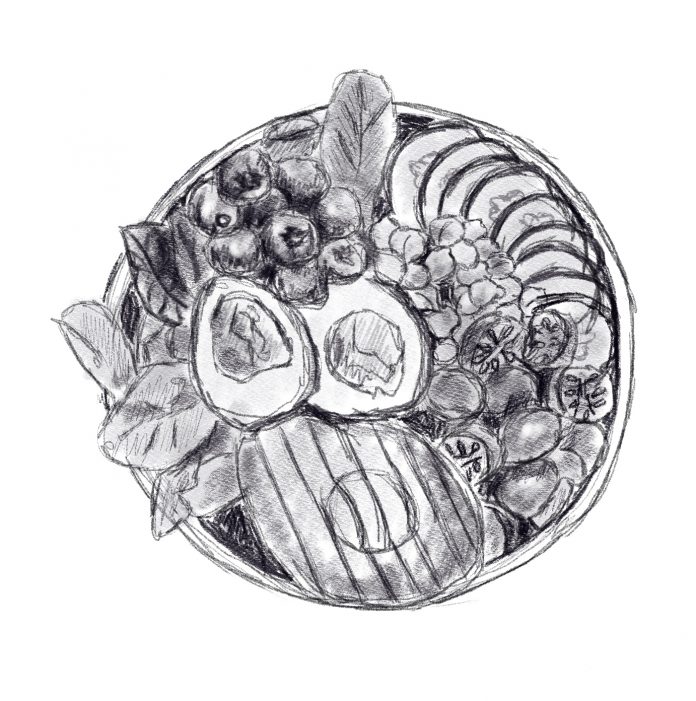Chances are that if you are a college student who has been on almost any form of social media in the past few years, you’ve been a witness to the rise of health, fitness and lifestyle influencers. From Instagram creators pushing the next three-week shred workout to social media stars whisking green powders or chlorophyll drops into water to kick off their day, there’s an overabundance of people on the Internet telling us about the next thing that will change our lives. In most cases, I feel like I can really get behind these influencers — if a health and fitness movement on social media is what it takes to get people to take their health seriously, then so be it. If there’s one thing I have trouble supporting though, it’s definitely diet fads and, in particular, the “clean eating” fad that became a pillar of the health and fitness communities in recent years.
On principle, “clean eating” is based on a sound idea — increasing your intake of whole and natural food groups has been proven to have positive mental and physical health effects. In my experience, increasing consumption of things like greens, whole grains and fresh produce can also leave you feeling more energized, satisfied and nourished.
However, the “clean eating” fad we’ve seen on social media in recent years approaches this diet from an entirely wrong angle: taking an exclusionary standpoint. Influencers preach to their audiences to cut out whole groups of food based on the premise that consuming even a little bit of it will have negative effects on your health. To many “clean eating” gurus, this diet means almost entirely cutting out prepackaged, processed or convenience foods — things like chips, processed bread, takeout, etc. Some even go so far as to cut out dairy and gluten based food groups on the idea that excluding them will lead to improved health, even though many human bodies are fully equipped to handle these forms of nutrients (and can even benefit from their inclusion in a day-to-day diet). This image is then curated on their accounts, in which influencers are only ever shown eating bowls of greens, whole grains or fresh produce.
This is a whole other problem — the way these influencers portray their day-to-day lives (and meals) has become some sort of aesthetic phenomenon. “Clean eating” has grown from a diet fad into an entire aesthetically healthy lifestyle, with exercise routines, clothing styles and even home décor styles now thrown into the mix. There’s nothing wrong with wanting to lead a comfortable, healthy life, but there is something wrong with pursuing this change purely for aesthetic reasons.
Clean eating and lifestyle influencers often reach their audiences through carefully curated, aesthetically pleasing social media images, which their audience then seeks to emulate in every possible way (I speak from experience here). To me, though, making a lifestyle or diet change based entirely on aesthetic value and wanting to copy media influencers is the entirely wrong way to go about making a helpful and lasting impact on your health and lifestyle. The goal in making a change should not be to live a shadow of the life you see shown through their Instagram account, but to tailor your life to your personal health needs.
It’s also important to realize that the images you see on these influential social media accounts are just that — images. They’re a carefully selected collection of images taken during specific moments in the account owner’s daily life with the specific intention to support the image that they have created for themself through social media. These parts only represent a small fraction of the whole; not every moment of that influencer’s every day is entirely perfect.
Despite all that I’ve said, I’m not an opponent of “clean eating” as a principle, I just dislike how it’s been portrayed in social media in recent years. Instead, I believe clean eating should encourage eating what feels good in your body and what makes you feel whole, satisfied and nourished — not excluding entire food groups on the premise that they will impede any progress you feel like you’re making in your health journey or encouraging a lifestyle change based purely on aesthetic value.
I’ve fallen for influencers’ posts before, trying to make lifestyle changes to reflect the images that make me think, “Wow, I want to be like her.” But I’ve learned to not live in the extremes I see on social media and that doing things in moderation will usually feel more comfortable and often leave you feeling much happier. Get takeout if you want it, eat a whole grain bowl if that sounds good. Listen to what your body and mind want; they won’t lead you astray.
While I don’t seek to influence anyone and just want to help those who want to hear from someone with experience in wrestling with health trends on social media, I have some advice I’d like to impart: If you’re thinking about making a change, do it for you and only you. And do it the way you want to. There’s no rulebook that says you must live your life according to that one beautifully aesthetic Instagram account — so don’t! The way you live your life and the changes you choose to make are entirely up to you and what feels good to your mind and body. Your first priority should always be making sure you feel whole, healthy and happy.

